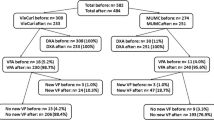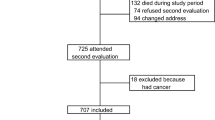Abstract
Summary
We evaluated vertebral fracture prevalence using DXA-based vertebral fracture assessment and its influence on the Fracture Risk Assessment (FRAX) tool-determined 10-year fracture probability in a cohort of oldest old nursing home residents. More than one third of the subjects had prevalent vertebral fracture and 50% osteoporosis. Probably in relation with the prevailing influence of age and medical history of fracture, adding these information into FRAX did not markedly modify fracture probability.
Introduction
Oldest old nursing home residents are at very high risk of fracture. The prevalence of vertebral fracture in this specific population and its influence on fracture probability using the FRAX tool are not known.
Methods
Using a mobile DXA osteodensitometer, we studied the prevalence of vertebral fracture, as assessed by vertebral fracture assessment program, of osteoporosis and of sarcopenia in 151 nursing home residents. Ten-year fracture probability was calculated using appropriately calibrated FRAX tool.
Results
Vertebral fractures were detected in 36% of oldest old nursing home residents (mean age, 85.9 ± 0.6 years). The prevalence of osteoporosis and sarcopenia was 52% and 22%, respectively. Ten-year fracture probability as assessed by FRAX tool was 27% and 15% for major fracture and hip fracture, respectively. Adding BMD or VFA values did not significantly modify it.
Conclusion
In oldest old nursing home residents, osteoporosis and vertebral fracture were frequently detected. Ten-year fracture probability appeared to be mainly determined by age and clinical risk factors obtained by medical history, rather than by BMD or vertebral fracture.
Similar content being viewed by others
References
Rudman IW, Rudman D (1989) High rate of fractures for men in nursing homes. Am J Phys Med Rehabil 68:2–5
Zimmerman SI, Girman CJ, Buie VC et al (1999) The prevalence of osteoporosis in nursing home residents. Osteoporos Int 9:151–157
Brennan Saunders J, Johansen A, Butler J et al (2003) Place of residence and risk of fracture in older people: a population-based study of over 65-year-olds in Cardiff. Osteoporos Int 14:515–519
Butler M, Norton R, Lee-Joe T et al (1996) The risks of hip fracture in older people from private homes and institutions. Age Ageing 25:381–385
Sugarman JR, Connell FA, Hansen A et al (2002) Hip fracture incidence in nursing home residents and community-dwelling older people, Washington State, 1993–1995. J Am Geriatr Soc 50:1638–1643
Schurch MA, Rizzoli R, Mermillod B et al (1996) A prospective study on socioeconomic aspects of fracture of the proximal femur. J Bone Miner Res 11:1935–1942
Nydegger V, Rizzoli R, Rapin CH et al (1991) Epidemiology of fractures of the proximal femur in Geneva: incidence, clinical and social aspects. Osteoporos Int 2:42–47
Lyles KW, Schenck AP, Colon-Emeric CS (2008) Hip and other osteoporotic fractures increase the risk of subsequent fractures in nursing home residents. Osteoporos Int 19:1225–1233
Berry SD, Samelson EJ, Ngo L et al (2008) Subsequent fracture in nursing home residents with a hip fracture: a competing risks approach. J Am Geriatr Soc 56:1887–1892
Nakamura K, Takahashi S, Oyama M et al (2010) Prior nonhip limb fracture predicts subsequent hip fracture in institutionalized elderly people. Osteoporos Int 21:1411–1416
Chandler JM, Zimmerman SI, Girman CJ et al (2000) Low bone mineral density and risk of fracture in white female nursing home residents. JAMA 284:972–977
Colon-Emeric CS, Biggs DP, Schenck AP et al (2003) Risk factors for hip fracture in skilled nursing facilities: who should be evaluated? Osteoporos Int 14:484–489
Girman CJ, Chandler JM, Zimmerman SI et al (2002) Prediction of fracture in nursing home residents. J Am Geriatr Soc 50:1341–1347
Fiatarone Singh MA, Singh NA, Hansen RD et al (2009) Methodology and baseline characteristics for the Sarcopenia and Hip Fracture study: a 5-year prospective study. J Gerontol A Biol Sci Med Sci 64:568–574
Lloyd BD, Williamson DA, Singh NA et al (2009) Recurrent and injurious falls in the year following hip fracture: a prospective study of incidence and risk factors from the Sarcopenia and Hip Fracture study. J Gerontol A Biol Sci Med Sci 64:599–609
Chevalley T, Guilley E, Herrmann FR et al (2007) Incidence of hip fracture over a 10-year period (1991–2000): reversal of a secular trend. Bone 40:1284–1289
Cooper C, Cole ZA, Holroyd CR et al (2011) Secular trends in the incidence of hip and other osteoporotic fractures. Osteoporos Int 22:1277–1288
Guilley E, Chevalley T, Herrmann F et al (2008) Reversal of the hip fracture secular trend is related to a decrease in the incidence in institution-dwelling elderly women. Osteoporos Int 19:1741–1747
Appelbaum PS (2007) Clinical practice. Assessment of patients’ competence to consent to treatment. N Engl J Med 357:1834–1840
Katz S, Ford AB, Moskowitz RW et al (1963) Studies of illness in the aged. The index of ADL: a standardized measure of biological and psychosocial function. JAMA 185:914–919
D’Hoore W, Guisset AL, Tilquin C (1997) Increased nursing-time requirements due to pressure sores in long-term-care residents in Quebec. Clin Perform Qual Health Care 5:189–194
Morin P, Herrmann F, Ammann P et al (2005) A rapid self-administered food frequency questionnaire for the evaluation of dietary protein intake. Clin Nutr 24:768–774
Kanis JA, Burlet N, Cooper C et al (2008) European guidance for the diagnosis and management of osteoporosis in postmenopausal women. Osteoporos Int 19:399–428
Lippuner K, Johansson H, Kanis JA et al (2009) Remaining lifetime and absolute 10-year probabilities of osteoporotic fracture in Swiss men and women. Osteoporos Int 20:1131–1140
Lewiecki EM, Laster AJ (2006) Clinical review: clinical applications of vertebral fracture assessment by dual-energy x-ray absorptiometry. J Clin Endocrinol Metab 91:4215–4222
Genant HK, Wu CY, van Kuijk C et al (1993) Vertebral fracture assessment using a semiquantitative technique. J Bone Miner Res 8:1137–1148
Baumgartner RN, Koehler KM, Gallagher D et al (1998) Epidemiology of sarcopenia among the elderly in New Mexico. Am J Epidemiol 147:755–763
Janssen I, Heymsfield SB, Ross R (2002) Low relative skeletal muscle mass (sarcopenia) in older persons is associated with functional impairment and physical disability. J Am Geriatr Soc 50:889–896
Beaupre LA, Majumdar SR, Dieleman S et al (2012) Diagnosis and treatment of osteoporosis before and after admission to long-term care institutions. Osteoporos Int 23:573–580
Lopes JB, Danilevicius CF, Takayama L et al (2011) Prevalence and risk factors of radiographic vertebral fracture in Brazilian community-dwelling elderly. Osteoporos Int 22:711–719
Black DM, Palermo L, Nevitt MC et al (1995) Comparison of methods for defining prevalent vertebral deformities: the Study of Osteoporotic Fractures. J Bone Miner Res 10:890–902
O’Neill TW, Felsenberg D, Varlow J et al (1996) The prevalence of vertebral deformity in european men and women: the European Vertebral Osteoporosis Study. J Bone Miner Res 11:1010–1018
Rizzoli R, Bruyere O, Cannata-Andia JB et al (2009) Management of osteoporosis in the elderly. Curr Med Res Opin 25:2373–2387
Sallin U, Mellstrom D, Eggertsen R (2005) Osteoporosis in a nursing home, determined by the DEXA technique. Med Sci Monit 11:CR67–CR70
Elliott ME, Binkley NC, Carnes M et al (2003) Fracture risks for women in long-term care: high prevalence of calcaneal osteoporosis and hypovitaminosis D. Pharmacotherapy 23:702–710
Giangregorio LM, Jantzi M, Papaioannou A et al (2009) Osteoporosis management among residents living in long-term care. Osteoporos Int 20:1471–1478
Becker C, Rapp K (2010) Fall prevention in nursing homes. Clin Geriatr Med 26:693–704
Frisoli A Jr, Chaves PH, Ingham SJ et al (2011) Severe osteopenia and osteoporosis, sarcopenia, and frailty status in community-dwelling older women: results from the Women’s Health and Aging Study (WHAS) II. Bone 48:952–957
Rapp K, Lamb SE, Klenk J et al (2009) Fractures after nursing home admission: incidence and potential consequences. Osteoporos Int 20:1775–1783
Colon-Emeric C, Lyles KW, Levine DA et al (2007) Prevalence and predictors of osteoporosis treatment in nursing home residents with known osteoporosis or recent fracture. Osteoporos Int 18:553–559
Jachna CM, Shireman TI, Whittle J et al (2005) Differing patterns of antiresorptive pharmacotherapy in nursing facility residents and community dwellers. J Am Geriatr Soc 53:1275–1281
Parikh S, Avorn J, Solomon DH (2009) Pharmacological management of osteoporosis in nursing home populations: a systematic review. J Am Geriatr Soc 57:327–334
Rojas-Fernandez CH, Lapane KL, MacKnight C et al (2002) Undertreatment of osteoporosis in residents of nursing homes: population-based study with use of the Systematic Assessment of Geriatric Drug Use via Epidemiology (SAGE) database. Endocr Pract 8:335–342
Gupta G, Aronow WS (2003) Underuse of procedures for diagnosing osteoporosis and of therapies for osteoporosis in older nursing home residents. J Am Med Dir Assoc 4:200–202
Kamel HK, Hussain MS, Tariq S et al (2000) Failure to diagnose and treat osteoporosis in elderly patients hospitalized with hip fracture. Am J Med 109:326–328
Parikh S, Mogun H, Avorn J et al (2008) Osteoporosis medication use in nursing home patients with fractures in 1 US state. Arch Intern Med 168:1111–1115
Landi F, Liperoti R, Fusco D et al (2012) Prevalence and risk factors of sarcopenia among nursing home older residents. J Gerontol A Biol Sci Med Sci 67:48–55
Guilley E, Herrmann F, Rapin CH et al (2011) Socioeconomic and living conditions are determinants of hip fracture incidence and age occurrence among community-dwelling elderly. Osteoporos Int 22:647–653
Lippuner K, Johansson H, Kanis JA et al (2010) FRAX assessment of osteoporotic fracture probability in Switzerland. Osteoporos Int 21:381–389
Acknowledgments
We are indebted to the nurses and all the care givers in the nursing homes, to Ms. C. Genet for DXA evaluations, Ms. M-A. Schaad RN, and A. Sigaud RN for the information delivered in the nursing homes. We thank the AETAS Foundation and the Geneva University Hospitals for their support. Ms. K. Giroux provided expert secretarial assistance.
Conflicts of interest
None.
Author information
Authors and Affiliations
Corresponding author
Rights and permissions
About this article
Cite this article
Rodondi, A., Chevalley, T. & Rizzoli, R. Prevalence of vertebral fracture in oldest old nursing home residents. Osteoporos Int 23, 2601–2606 (2012). https://doi.org/10.1007/s00198-012-1900-6
Received:
Accepted:
Published:
Issue Date:
DOI: https://doi.org/10.1007/s00198-012-1900-6




